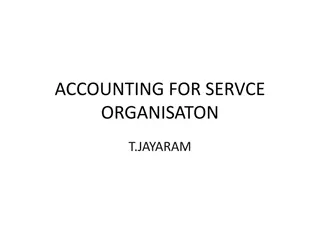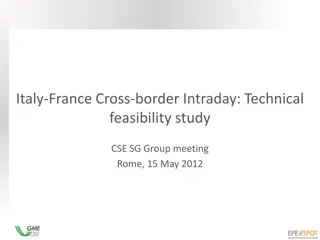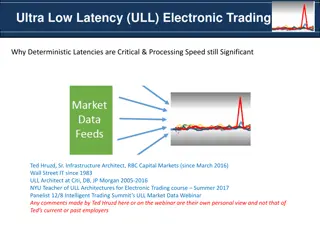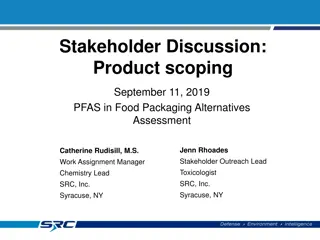Mid-Term Trading Strategy Architecture Hypothesis
There are mid-term investment opportunities with US Stocks involving high momentum and low risk behavior, yielding profitable returns. This strategy aims to be executed with low initial capital using specific tools and processes. It involves initializing and downloading historical data, cleaning and pre-processing the data, and analyzing patterns for effective trading decisions.
Download Presentation

Please find below an Image/Link to download the presentation.
The content on the website is provided AS IS for your information and personal use only. It may not be sold, licensed, or shared on other websites without obtaining consent from the author.If you encounter any issues during the download, it is possible that the publisher has removed the file from their server.
You are allowed to download the files provided on this website for personal or commercial use, subject to the condition that they are used lawfully. All files are the property of their respective owners.
The content on the website is provided AS IS for your information and personal use only. It may not be sold, licensed, or shared on other websites without obtaining consent from the author.
E N D
Presentation Transcript
Layered Architecture The main aim of the layered architecture is to divide the design into small pieces. Each lower layer adds its services to the higher layer to provide a full set of services to manage communications and run the applications. It provides modularity and clear interfaces, i.e., provides interaction between subsystems. It ensures the independence between layers by providing the services from lower to higher layer without defining how the services are implemented. Therefore, any modification in a layer will not affect the other layers. The number of layers, functions, contents of each layer will vary from network to network. However, the purpose of each layer is to provide the service from lower to a higher layer and hiding the details from the layers of how the services are implemented.
The basic elements of layered architecture are services, protocols, and interfaces. Service: It is a set of actions that a layer provides to the higher layer. Protocol: It defines a set of rules that a layer uses to exchange the information with peer entity. These rules mainly concern about both the contents and order of the messages used. Interface: It is a way through which the message is transferred from one layer to another layer. LAYERED MODEL In a layer n architecture, layer n on one machine will have a communication with the layer n on another machine and the rules used in a conversation are known as a layer-n protocol.
In case of layered architecture, no data is transferred from layer n of one machine to layer n of another machine. Instead, each layer passes the data to the layer immediately just below it, until the lowest layer is reached. Below layer 1 is the physical medium through which the actual communication takes place. In a layered architecture, unmanageable tasks are divided into several small and manageable tasks. The data is passed from the upper layer to lower layer through an interface. A Layered architecture provides a clean-cut interface so that minimum information is shared among different layers. It also ensures that the implementation of one layer can be easily replaced by another implementation. A set of layers and protocols is known as network architecture.
OSI & TCP/IP MODELS https://www.slideshare.net/pavankumar815/unit-1-introduction-to- computer-networks [Slide38-Slide47] TCP/IP PROTOCOL SUITE Transmission Control Protocol/Internet Protocol. It is a set of protocols organized in different layers. It is a hierarchical protocol made of interactive modules. The term hierarchical means that each upper level protocol is supported by the services provided by 1 or more lower level protocols. The original TCP/IP protocol suite was defined as 4 software layers built upon the hardware. Physical +data link layer combined to form host-to-network layer. Today,it is thought of 5-layer model(hybrid model).
Layers in the TCP/IP protocol suite(hybrid model)
Application, transport,network layers are end-to-end. Data link and physical layers hop-to-hop,in which a hop is a host or router. Principles of protocol layering 1.If we want a bidirectional communication ,we need to make each layer so that it is able to perform 2 opposite tasks,one in each direction. Eg:-third layer listen(in 1 direction) and talk(in other direction) Sec layer encrypt & decrypt. First layer send & receive. 2.Two objects under each layer at both sides should be identical.
The TCP/IP model was developed prior to the OSI model. Description of each layer 1.Physical layer Responsible for carrying individual bits in a frame across the link. Lowest level in which communication between 2 devices connected through either transmission media-cable or air. Transmission media does not carry bits;it carries electrical or optical signals. There are several protocols to transform a bit to a signal. 2.Data-link Layer There are several overlapping set of links that a datagram can travel from the host to the destination. Routers are responsible for choosing the link.
The link can be a wired-LAN with a link-layer switch,a wireless LAN,a wired WAN,or a wireless WAN. The data link layer takes a datagram & encapsulates it in a packet called a frame. Some link layer provide complete error detection and correction,some provide only error correction. Network Layer or Network Access Layer(host-to-network) A network layer is the lowest layer of the TCP/IP model. A network layer is the combination of the Physical layer and Data Link layer defined in the OSI reference model. It defines how the data should be sent physically through the network. This layer is mainly responsible for the transmission of the data between two devices on the same network. The functions carried out by this layer are encapsulating the IP datagram into frames transmitted by the network and mapping of IP addresses into physical addresses. The protocols used by this layer are ethernet, token ring, FDDI, X.25, frame relay.
Internet or network layer An internet layer is the second layer of the TCP/IP model. The main responsibility of the internet layer is to send the packets from any network, and they arrive at the destination irrespective of the route they take. The communication at the network layer is host-to-host. Routing is done in this layer. The network layer includes the main protocol IP(Internet Protocol). It is a connectionless protocol. Following are the responsibilities of this protocol:- IP Addressing Host-to-host communication: Fragmentation and Reassembly Routing IP defines the format of the packet called a datagram & structure of addresses used in this layer.
The network layer has some auxiliary protocols that help IP in its delivery and routing tasks. ICMP-Internet Control Messge Protocol-helps IP to report some problems when routing a packet. IGMP-The Internet Group Management Protocol- helps IP in multitasking. DHCP-Dynamic Host Configuration Protocol-helps IP to get the network-layer address for a host. ARP-the Address Resolution Protocol-helps IP to find the link-layer address of a host or router when its network-layer address is given. Transport Layer The logical connection at the transport layer is end-to-end. The transport layer at the source host gets the message from the application layer,encapsulates it in a transport -layer packet(called a segment or a user datagram in different protocols) and sends it,through the logical(imaginary) connection,to the transport layer at the destination host.
Transport layer is responsible for giving services to the application layer. Protocols used here are TCP,UDP,SCTP TCP-Transmission Control Protocol Reliable Connection-oriented protocol Creates logical connection Flow control-Matching the sending data rate of the source host with the receiving data rate of the destination host to prevent overwhelming the destination. Error control To guarantee that the segments arrive at the destination without error and resending the corrupted ones. Congestion control-to reduce the loss of segments due to congestion in the network. UDP-User Datagram Protocol Unreliable Connection-less protocol
UDP is a simple protocol that does not provide flow,error,or congestion control. Creates no logical connection. SCTP-Stream Control Transmission Protocol Designed to respond to new applications that are emerging in the multimedia. It fragments the incoming byte stream into discrete messages and passes each one onto the internet layer. At the destination ,the receiving TCP process reassembles the received messages into the output stream.
Application Layer Logical connection between the 2 application layers is end-to-end. Communication at the application layer is between 2 processes. Process-to-process communication is the duty of the application layer. HTTP-Hypertext Transfer Protocol vehicle for accessing the World Wide Web(WWW). SMTP-Simple Mail Transfer Protocol main protocol used in email services. FTP-File Transfer Protocol-used for transferring files from one host to another. TELNET(Terminal Network) and Secure Shell(SSH) used for accessing a site remotely. SNMP-Simple Network Management Protocol used by an administrator to manage the internet at global and local levels. DNS-Domain Name System-used by other protocols to find the network- layer address of a computer. IGMP-Internet Group Management Protocol used to collect membership in a group.
Encapsulation at the source host 1.Message passed to transport layer. 2.In transport layer we take message as payload and adds transport layer header.It contains identifiers of the source and destination application programs plus information for end-to-end delivery.Transport layer packet is called as segment(in TCP) and user datagram(in UDP).The transport layer passes the packet to the network layer. 3.Network layer adds its own header to the payload.Also information for error checking,fragmentation etc.The network layer then passes the packet to the data link layer. 4.The datalink layer takes the network layer packet adds its header,which contains the link-layer addresses of the host or the next hop(the router).We get frames from here.The frame is passed to the physical layer for transmission.
Decapsualtion & Encapsulation at the router Both because the router is connected to 2 or more links. 1.After the set of bits are delivered to the data-link layer,this layer decapsulates the datagram from the frame and passes it to the network layer. 2.Network layer inspects the source and destination addresses in the datagram header and consults its forwarding table to find the next hop to which the datagram is to delivered. 3.The datalink layer of the next link encapsulates the datagram in a frame and passes it to physical layer for transmission. Decapsulation at the Destination Host 1.At destination host ,each layer only decapsulates the packet received,removes the payload and delivers the payload to the next- higher layer protocol until the message reaches the application layer. 2.At host also while decapsulating ,involves error checking.
Names-someorg.com Logical address - 16-bit addresses in its instructions, the logical address space would be 0 .. 65535. Link-layer addresses MAC address
MULTIPLEXING & DEMULTIPLEXING Multiplexing protocol at a layer can encapsulate a packet from several next-higher layer protocols(one at a time). Demultiplexing a protocol can decapsulate and deliver a packet to several next-higher layer protocols.
THE OSI MODEL An ISO standard that covers all aspects of network communications is the Open Systems Interconnection(OSI) model. An open system is a set of protocols that allows any 2 different systems to communicate regardless of their underlying architecture. The purpose of the OSI model is to show how to facilitate communication between different systems without requiring changes to the logic of the underlying hardware and software. OSI model is not a protocol;it is a model of understanding and designing a network architecture that is flexible,robust and interoperable. It consists of 7 separate but related layers.
The Physical layer The main functionality of the physical layer is to transmit the individual bits from one node to another node. It is the lowest layer of the OSI model. It establishes, maintains and deactivates the physical connection. It specifies the mechanical, electrical and procedural network interface specifications. Here we have to decide how many volts is used to represent a 1 and how many for a 0,how many microseconds a bit lasts. Line Configuration: It defines the way how two or more devices can be connected physically. Data Transmission: It defines the transmission mode whether it is simplex, half-duplex or full-duplex mode between the two devices on the network. Topology: It defines the way how network devices are arranged. Signals: It determines the type of the signal used for transmitting the information.
The Data Link Layer This layer is responsible for the error-free transfer of data frames. For this acknowledgement frames are attached. It defines the format of the data on the network. It provides a reliable and efficient communication between two or more devices. It is mainly responsible for the unique identification of each device that resides on a local network. It contains two sub-layers: Logical Link Control Layer It is responsible for transferring the packets to the Network layer of the receiver that is receiving. It identifies the address of the network layer protocol from the header. It also provides flow control. Media Access Control Layer A Media access control layer is a link between the Logical Link Control layer and the network's physical layer. It is used for transferring the packets over the network.
Functions of the Data-link layer Framing: The data link layer translates the physical's raw bit stream into packets known as Frames. The Data link layer adds the header and trailer to the frame. The header which is added to the frame contains the hardware destination and source address. Physical Addressing: The Data link layer adds a header to the frame that contains a destination address. The frame is transmitted to the destination address mentioned in the header. Flow Control: Flow control is the main functionality of the Data-link layer. It is the technique through which the constant data rate is maintained on both the sides so that no data get corrupted. It ensures that the transmitting station such as a server with higher processing speed does not exceed the receiving station, with lower processing speed. Error Control: Error control is achieved by adding a calculated value CRC (Cyclic Redundancy Check) that is placed to the Data link layer's trailer which is added to the message frame before it is sent to the physical layer. If any error seems to occurr, then the receiver sends the acknowledgment for the retransmission of the corrupted frames. Access Control: When two or more devices are connected to the same communication channel, then the data link layer protocols are used to determine which device has control over the link at a given time.
Network layer It is a layer 3 that manages device addressing, tracks the location of devices on the network. It determines the best path to move data from source to the destination based on the network conditions, the priority of service, and other factors. Routers are the layer 3 devices, they are specified in this layer and used to provide the routing services within an internetwork. The protocols used to route the network traffic are known as Network layer protocols. Examples of protocols are IP and Ipv6.
Functions of Network Layer:- Internetworking: An internetworking is the main responsibility of the network layer. It provides a logical connection between different devices. Addressing: A Network layer adds the source and destination address to the header of the frame. Addressing is used to identify the device on the internet. Routing: Routing is the major component of the network layer, and it determines the best optimal path out of the multiple paths from source to the destination. Packetizing: A Network Layer receives the packets from the upper layer and converts them into packets. This process is known as Packetizing. It is achieved by internet protocol (IP).
Transport Layer The Transport layer is a Layer 4 ensures that messages are transmitted in the order in which they are sent and there is no duplication of data. The main responsibility of the transport layer is to transfer the data completely. It receives the data from the upper layer and converts them into smaller units known as segments. This layer can be termed as an end-to-end layer as it provides a point- to-point connection between source and destination to deliver the data reliably. The two protocols used in this layer are: Transmission Control Protocol It is a standard protocol that allows the systems to communicate over the internet.
It establishes and maintains a connection between hosts. When data is sent over the TCP connection, then the TCP protocol divides the data into smaller units known as segments. Each segment travels over the internet using multiple routes, and they arrive in different orders at the destination. The transmission control protocol reorders the packets in the correct order at the receiving end. User Datagram Protocol User Datagram Protocol is a transport layer protocol. It is an unreliable transport protocol as in this case receiver does not send any acknowledgment when the packet is received, the sender does not wait for any acknowledgment. Therefore, this makes a protocol unreliable.
Functions of Transport Layer: Service-point addressing: Computers run several programs simultaneously due to this reason, the transmission of data from source to the destination not only from one computer to another computer but also from one process to another process. The transport layer adds the header that contains the address known as a service-point address or port address. The responsibility of the network layer is to transmit the data from one computer to another computer and the responsibility of the transport layer is to transmit the message to the correct process. Segmentation and reassembly: When the transport layer receives the message from the upper layer, it divides the message into multiple segments, and each segment is assigned with a sequence number that uniquely identifies each segment. When the message has arrived at the destination, then the transport layer reassembles the message based on their sequence numbers.
Connection control: Transport layer provides two services Connection-oriented service and connectionless service. A connectionless service treats each segment as an individual packet, and they all travel in different routes to reach the destination. A connection-oriented service makes a connection with the transport layer at the destination machine before delivering the packets. In connection-oriented service, all the packets travel in the single route. Flow control: The transport layer also responsible for flow control but it is performed end-to-end rather than across a single link. Error control: The transport layer is also responsible for Error control. Error control is performed end-to-end rather than across the single link. The sender transport layer ensures that message reach at the destination without any error.
Session Layer It is a layer 3 in the OSI model. The Session layer is used to establish, maintain and synchronizes the interaction between communicating devices. Functions of Session layer:- Dialog control: Session layer acts as a dialog controller that creates a dialog between two processes or we can say that it allows the communication between two processes which can be either half- duplex or full-duplex. Synchronization: Session layer adds some checkpoints when transmitting the data in a sequence. If some error occurs in the middle of the transmission of data, then the transmission will take place again from the checkpoint. This process is known as Synchronization and recovery.
Presentation Layer A Presentation layer is mainly concerned with the syntax and semantics of the information exchanged between the two systems. It acts as a data translator for a network. This layer is a part of the operating system that converts the data from one presentation format to another format. The Presentation layer is also known as the syntax layer. Functions of Presentation layer:- Translation: The processes in two systems exchange the information in the form of character strings, numbers and so on. Different computers use different encoding methods, the presentation layer handles the interoperability between the different encoding methods. It converts the data from sender-dependent format into a common format and changes the common format into receiver-dependent format at the receiving end. Encryption: Encryption is needed to maintain privacy. Encryption is a process of converting the sender-transmitted information into another form and sends the resulting message over the network. Compression: Data compression is a process of compressing the data, i.e., it reduces the number of bits to be transmitted. Data compression is very important in multimedia such as text, audio, video.
Application Layer An application layer serves as a window for users and application processes to access network service. It handles issues such as network transparency, resource allocation, etc. An application layer is not an application, but it performs the application layer functions. This layer provides the network services to the end-users. Functions of Application layer:- File transfer, access, and management (FTAM): An application layer allows a user to access the files in a remote computer, to retrieve the files from a computer and to manage the files in a remote computer. Mail services: An application layer provides the facility for email forwarding and storage. Directory services: An application provides the distributed database sources and is used to provide that global information about various objects.


![Guardians of Collection Enhancing Your Trading Card Experience with the Explorer Sleeve Bundle [4-pack]](/thumb/3698/guardians-of-collection-enhancing-your-trading-card-experience-with-the-explorer-sleeve-bundle-4-pack.jpg)




















